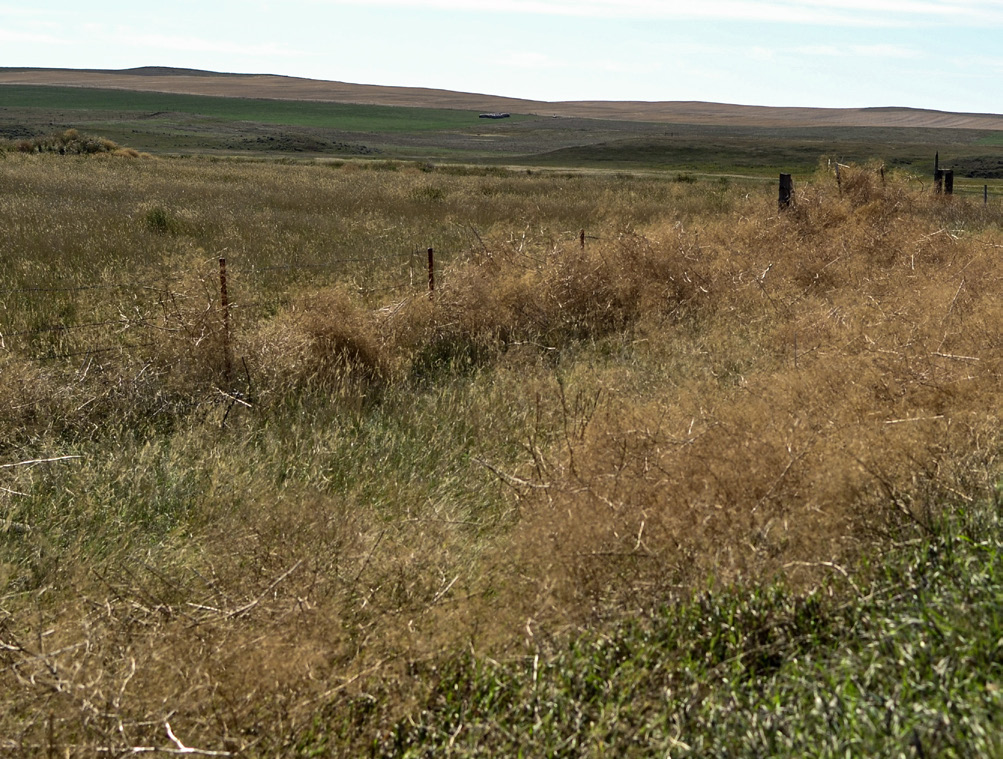Invasive Ornamental: Baby's Breath

Photo: Adobe Stock
While florist varieties of Baby’s Breath may look a little different, this ornamental has become an invasive species in rangeland.
Baby’s breath (Gypsophila paniculata L.) is a perennial flowering plant used in flower arrangements. It was introduced to North America for ornamental purposes as early as 1887 and was first documented in the Pacific Northwest in 1931. It was often planted around homesteads and cemeteries. Baby’s breath is still used extensively in the floral industry but has escaped gardens and spread into rangeland and pastures. Some states and Canadian provinces have listed it as a noxious weed. Baby’s breath can form very dense stands and is associated with negative impacts on forage production, especially in CRP (Conservation Reserve Program) and rangeland (Figure 1).

Photo: Inga Hawbaker, MSU Extension
Figure 1. Gypsophila paniculata infestation in Conservation Reserve Program acres.
Baby’s breath can reach three to four feet in height and width. The leaves are linear-lanceolate with an opposite arrangement, and arise from swollen nodes. Leaves are one to four inches long, and are blue-green to grey-green. The leaves on the top portion of the plant are smaller than those on the lower portion; as the plant develops flower buds, foliage becomes sparse. The large inflorescence is open with many five-petaled flowers that range in color from white to light purple (Figure 2). The inflorescence makes a globe-like growth and has a cloud-like appearance (Figure 3). The fruit is a round capsule comprised of four valves in which as many as four seeds develop. The fruit reaches maturity four to five weeks after the first buds open.

Photo: Inga Hawbaker, MSU Extension
Figure 2. Gypsophila paniculata flower and flower buds.

Photo: Inga Hawbaker, MSU Extension
Figure 3. Gypsophila paniculata plant in hayfield.
Baby’s breath is native to Eurasia and is broadly adapted to continental climate conditions and makes many seeds. It colonizes areas with coarse-textured soils and can withstand variation in moisture and temperature. Baby’s breath has a thick taproot that can reach depths of 13 feet, aiding its ability to survive in areas of low rainfall. Seedlings exhibit a rapid rate of root penetration in the first two years of growth. Reproduction is dependent on seed production, with a single plant annually producing nearly 14,000 seeds; plants usually do not become reproductive until the third year. Plant shoots emerge early in spring; seeds tend to germinate during this time as well, but seeds exhibit little to no dormancy, prompting high rates of germination when temperature and moisture conditions allow (Figure 4). Seed is thought to remain viable in the soil for up to two years.

Photo: Inga Hawbaker, MSU Extension
Figure 4. Gypsophila paniculata shoots in early spring.
Wind is the most important agent of seed dispersal. Late in the season, plant stems become dry and brittle; strong winds cause interwoven stems to break at the base and tumble across the landscape. Although most seeds are dropped near the parent plant, seeds in the capsules can be carried a great distance. This tumbling behavior results in infestations commonly found along roadsides, ravines, and fence lines (Figure 5).

Photo: Inga Hawbaker, MSU Extension
Figure 5. Gypsophila paniculata plants caught in fence along roadside.
Although baby’s breath is not a state-listed noxious weed in Montana, it has been reported in 26 of 56 counties in Montana since 1934, and has been listed by the Montana Department of Agriculture as a noxious weed in the following 14 counties: Blaine, Broadwater, Chouteau, Daniels, Deer Lodge, Flathead, Jefferson, Ravalli, Richland, Roosevelt, Sanders, Sheridan, Silver Bow, and Valley (Figure 6). Baby’s breath has become especially problematic in idle croplands, rangeland, and hayfields in northeastern Montana.

Figure 6. Photo: Steve Dewey, Utah State University, Bugwood.org
Our understanding of the invasive potential of baby’s breath and the ecological and economic consequences has progressed in recent years. However, management of the invasive species still poses a challenge. MSU Extension agents and specialists set up a study on management of baby’s breath in rangeland and CRP. Mechanical, cultural, and chemical control methods are used, often with varied results. Baby’s breath has been known to tolerate shallow tillage, but frequent, deep tillage can stave off establishment and survival of plants. But tilling has implications for soil erosion, soil heath, and habitat provided by rangeland and CRP. In the study, mowing after the bird nesting period did not affect vigor or density of baby’s breath and should not be used as a standalone treatment. Ideally, if possible, mowing or haying operations should take place before flowering to inhibit seed production. Intensive grazing in the early vegetative stage has been shown to reduce plant vigor and seed production, but as the plant nears flowering, nutritional value and palatability decrease.
An herbicide with the active ingredient metsulfuron-methyl (Escort® XP, Omni® Brand MSM 60 DF) reduced baby’s breath without harming perennial grass cover. Treatment is recommended when baby’s breath is post-emergent, during the bolt to pre-flower stages. In a recent study near Peerless, Montana, spring herbicide applications containing the active ingredient metsulfuron-methyl significantly reduced the density of baby’s breath at the end of the three-year study. Prior research conducted regarding long-term control of baby’s breath in Montana is limited, therefore additional years of monitoring will determine the long-term effects of the herbicide treatments and refinement of management decisions.
Additional Resources
MSU Extension Invasive Plants, Monthly Weed Post, May 2021
www.montana.edu/extension/invasiveplants/extension/monthly-weed-posts/2021-may-babys-breath.html
MSU Extension Invasive Plants, Monthly Weed Post, May 2015
www.montana.edu/extension/invasiveplants/extension/monthly-weed-posts/2015_may.html
Weed Control Handbook, University of California-Davis
wric.ucdavis.edu/information/natural%20areas/wr_G/Gypsophila.pdf
Inga Hawbaker is the MSU Extension Agent in Daniels County; Tim Seipel is the MSU Extension Cropland Weed Specialist.
